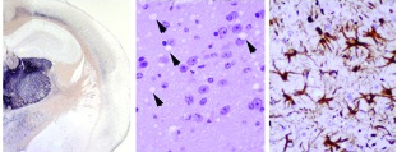What are the structural determinants of the prion protein that impact conversion? How can prion conversion be blocked?
The molecular mechanisms that underlie prion aggregation and transmission between species are poorly understood. Therefore another research focus is to identify the key residues and segments of the prion protein that control conversion and govern species barriers.
The β2-α2 loop of the prion protein (amino acids 165-175) is a site of exceptionally high sequence variability. Microcrystallography performed in David Eisenberg’s laboratory has revealed that adjacent β2-α2 segments align such that amino acids side chains from β-sheets intermesh in a dry interface, known as a ‘steric zipper’, as part of the amyloid core. We have discovered that amino acid substitutions in the β2-α2 loop block conversion, potentially through inhibiting the formation of a tight steric zipper. This molecular incompatability can have a major impact on susceptibility to prion disease, particularly human susceptibility to chronic wasting disease (CWD) prions.
We have also found that key asparagine and glutamine residues within steric zipper segments of the prion protein have a powerful role in promoting prion conversion. We continue to determine the role of critical residues for conformational conversion to resolve the fundamental underpinnings of prion protein aggregation. We work together with David Eisenberg, Lin Jiang, Jose Rodriguez, and other structural biology experts toward the rationale design of therapeutics to block prion aggregation.

Model based on microcrystallography of PrP segment shows an interface between two PrP molecules in which amino acid side chains tightly interdigitate in a dry steric zipper.Transgenic mice in which the amino acid sequence was altered to create a tight steric zipper in a key PrP segment shows the mice are now prion susceptible, indicating that disruptin these key side chain interactions could prevent prion aggregation.

